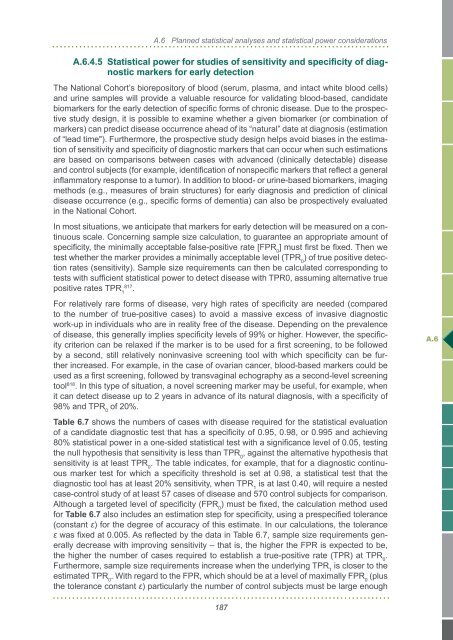Scientific Concept of the National Cohort (status ... - Nationale Kohorte
Scientific Concept of the National Cohort (status ... - Nationale Kohorte
Scientific Concept of the National Cohort (status ... - Nationale Kohorte
You also want an ePaper? Increase the reach of your titles
YUMPU automatically turns print PDFs into web optimized ePapers that Google loves.
A.6 Planned statistical analyses and statistical power considerations<br />
A.6.4.5 Statistical power for studies <strong>of</strong> sensitivity and specificity <strong>of</strong> diagnostic<br />
markers for early detection<br />
The <strong>National</strong> <strong>Cohort</strong>’s biorepository <strong>of</strong> blood (serum, plasma, and intact white blood cells)<br />
and urine samples will provide a valuable resource for validating blood-based, candidate<br />
biomarkers for <strong>the</strong> early detection <strong>of</strong> specific forms <strong>of</strong> chronic disease. Due to <strong>the</strong> prospective<br />
study design, it is possible to examine whe<strong>the</strong>r a given biomarker (or combination <strong>of</strong><br />
markers) can predict disease occurrence ahead <strong>of</strong> its “natural” date at diagnosis (estimation<br />
<strong>of</strong> “lead time"). Fur<strong>the</strong>rmore, <strong>the</strong> prospective study design helps avoid biases in <strong>the</strong> estimation<br />
<strong>of</strong> sensitivity and specificity <strong>of</strong> diagnostic markers that can occur when such estimations<br />
are based on comparisons between cases with advanced (clinically detectable) disease<br />
and control subjects (for example, identification <strong>of</strong> nonspecific markers that reflect a general<br />
inflammatory response to a tumor). In addition to blood- or urine-based biomarkers, imaging<br />
methods (e.g., measures <strong>of</strong> brain structures) for early diagnosis and prediction <strong>of</strong> clinical<br />
disease occurrence (e.g., specific forms <strong>of</strong> dementia) can also be prospectively evaluated<br />
in <strong>the</strong> <strong>National</strong> <strong>Cohort</strong>.<br />
In most situations, we anticipate that markers for early detection will be measured on a continuous<br />
scale. Concerning sample size calculation, to guarantee an appropriate amount <strong>of</strong><br />
specificity, <strong>the</strong> minimally acceptable false-positive rate [FPR ] must first be fixed. Then we<br />
0<br />
test whe<strong>the</strong>r <strong>the</strong> marker provides a minimally acceptable level (TPR ) <strong>of</strong> true positive detec-<br />
0<br />
tion rates (sensitivity). Sample size requirements can <strong>the</strong>n be calculated corresponding to<br />
tests with sufficient statistical power to detect disease with TPR0, assuming alternative true<br />
817 positive rates TPR . 1<br />
For relatively rare forms <strong>of</strong> disease, very high rates <strong>of</strong> specificity are needed (compared<br />
to <strong>the</strong> number <strong>of</strong> true-positive cases) to avoid a massive excess <strong>of</strong> invasive diagnostic<br />
work-up in individuals who are in reality free <strong>of</strong> <strong>the</strong> disease. Depending on <strong>the</strong> prevalence<br />
<strong>of</strong> disease, this generally implies specificity levels <strong>of</strong> 99% or higher. However, <strong>the</strong> specificity<br />
criterion can be relaxed if <strong>the</strong> marker is to be used for a first screening, to be followed<br />
by a second, still relatively noninvasive screening tool with which specificity can be fur<strong>the</strong>r<br />
increased. For example, in <strong>the</strong> case <strong>of</strong> ovarian cancer, blood-based markers could be<br />
used as a first screening, followed by transvaginal echography as a second-level screening<br />
tool818 . In this type <strong>of</strong> situation, a novel screening marker may be useful, for example, when<br />
it can detect disease up to 2 years in advance <strong>of</strong> its natural diagnosis, with a specificity <strong>of</strong><br />
98% and TPR <strong>of</strong> 20%.<br />
0<br />
Table 6.7 shows <strong>the</strong> numbers <strong>of</strong> cases with disease required for <strong>the</strong> statistical evaluation<br />
<strong>of</strong> a candidate diagnostic test that has a specificity <strong>of</strong> 0.95, 0.98, or 0.995 and achieving<br />
80% statistical power in a one-sided statistical test with a significance level <strong>of</strong> 0.05, testing<br />
<strong>the</strong> null hypo<strong>the</strong>sis that sensitivity is less than TPR 0 , against <strong>the</strong> alternative hypo<strong>the</strong>sis that<br />
sensitivity is at least TPR 0 . The table indicates, for example, that for a diagnostic continuous<br />
marker test for which a specificity threshold is set at 0.98, a statistical test that <strong>the</strong><br />
diagnostic tool has at least 20% sensitivity, when TPR 1 is at last 0.40, will require a nested<br />
case-control study <strong>of</strong> at least 57 cases <strong>of</strong> disease and 570 control subjects for comparison.<br />
Although a targeted level <strong>of</strong> specificity (FPR 0 ) must be fixed, <strong>the</strong> calculation method used<br />
for Table 6.7 also includes an estimation step for specificity, using a prespecified tolerance<br />
(constant ε) for <strong>the</strong> degree <strong>of</strong> accuracy <strong>of</strong> this estimate. In our calculations, <strong>the</strong> tolerance<br />
ε was fixed at 0.005. As reflected by <strong>the</strong> data in Table 6.7, sample size requirements generally<br />
decrease with improving sensitivity – that is, <strong>the</strong> higher <strong>the</strong> FPR is expected to be,<br />
<strong>the</strong> higher <strong>the</strong> number <strong>of</strong> cases required to establish a true-positive rate (TPR) at TPR 0 .<br />
Fur<strong>the</strong>rmore, sample size requirements increase when <strong>the</strong> underlying TPR 1 is closer to <strong>the</strong><br />
estimated TPR 0 . With regard to <strong>the</strong> FPR, which should be at a level <strong>of</strong> maximally FPR 0 (plus<br />
<strong>the</strong> tolerance constant ε) particularly <strong>the</strong> number <strong>of</strong> control subjects must be large enough<br />
187<br />
A.6



